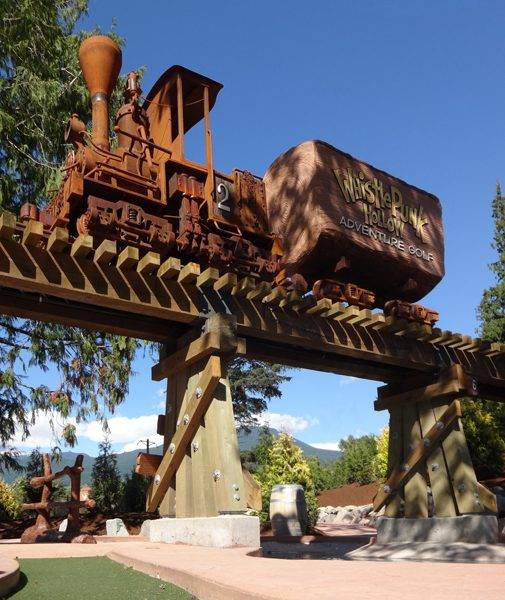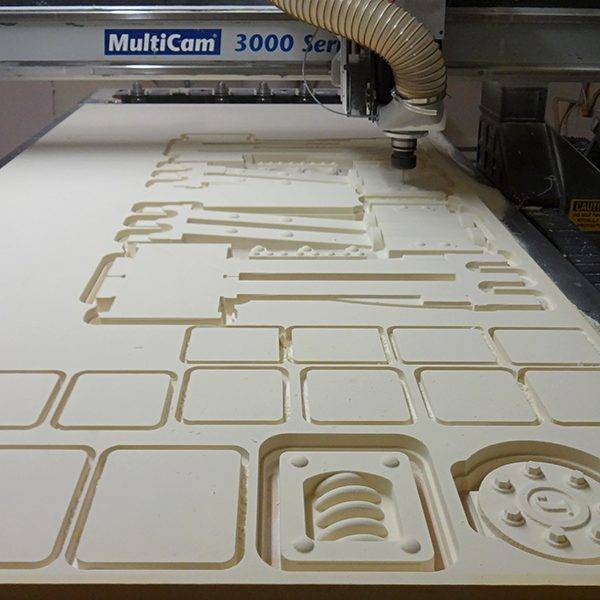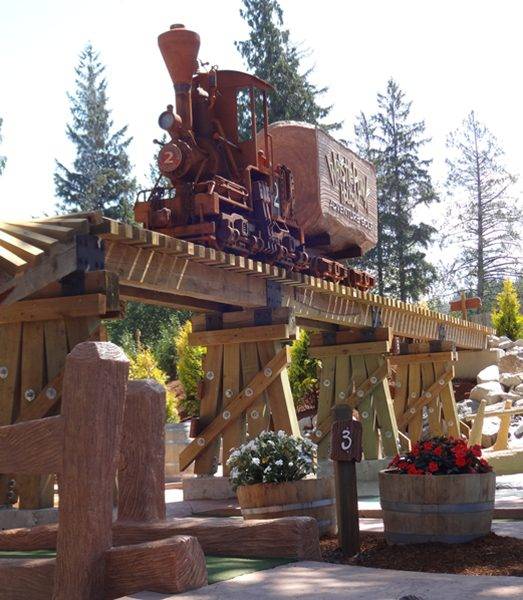Coastal Enterprises, manufacturers of Precision Board HDU, is proud to announce a series of guest blogs written by Dan Sawatzky of Imagination Corporation, posted to the Precision Board Blog each month.
This month Dan Sawatzky tells us how he created a cartoonish-looking steam-powered train out of real steel and 30lb Precision Board HDU coated to look like rusted metal for a theme park. Dan’s work is so good that you can’t tell what’s actually metal and what is faux steel. Read on to see why Sawatzky used a combination of metal & HDU made to look like metal for his train and how he pulled it all off.

In Dan Sawatzky’s own words…
I thought I’d do an article on a train I built six years ago. It was done for a mini golf park which we designed. Now, the golf park has been closed to make way for a housing development. The train and all the other features we built for the golf park have been carefully removed and will be reused in another project which is soon to be built. I had a chance to look over the features this past summer. They are holding up great – a testament to how well Precision Board holds up!
The old steam-powered locomotives have long been a personal favourite. A number of years ago, just after we got our MultiCam, I got the chance to build a slightly cartoonized version. It was challenging, but a whole lot of fun!

While a fair amount of the train engine would be built of welded steel, Shay locomotives have a lot of intricate details which I knew would route perfectly from 30 lb Precision Board. The router would speed things up a whole bunch and once painted with a rusting paint would be impossible to tell from the real thing.
I first did a scale concept drawing. This was approved by the customer. I would scale up the concept to create a locomotive that was about eight feet long and six feet tall. I imported the concept sketch into EnRoute to create the vector drawings I would need for the routing files. Many of the pieces needed to be layered to get the heavy duty ‘castings’ I needed. The bulk of the bigger pieces were routed from 2” thick 30 lb Precision Board. The wheels were routed from 3” thick board. The balance of the smaller pieces were routed from 1” thick 30 lb board. Since this was to be a static display even the train rails were routed from Precision Board. There were more than a hundred pieces in all.
I routed the wheels first so I could begin building the frame of the train while the rest were running. I mocked up the pieces first to make sure it looked right, then when I was happy, I welded things into place securely.
The boiler of the train was made with scrap sections of pipe. The bulk of the upper portion of the train was made of steel for strength. The routed bits were fastened to this structure. Most of the train was assembled in place on the train to facilitate finishing in a logical order.
I painted the Precision Board with a reactive iron paint and with a little spritz of the activator (a mild acid) the rust quickly formed on the Precision Board pieces as well as the raw steel components I used. It was impossible to tell which was real steel and which was not.
Once each assembly was finished I moved on to the next, working my way up the train.
While I was working on the train we learned the sad news that our niece was still born. I decided to name the little locomotive in her honour. A special name plate was created and mounted on the back of the cab.

I had been collecting old rusty chains for quite some time and this was the perfect place to use them. The jewelry was the perfect touch to make the train look real! The smokestack was the last piece added. We had it custom-made in a local machine shop as they had the necessary equipment.
The train was numbered with the numeral two as I often do. The reason is that I am the second child in my family. This is my way of signing my work.
Once complete the train was loaded onto our little flat deck trailer and hauled to our customer’s work site. He had a giant excavator waiting and in a few minutes the train was sitting high on the trestle he had built for the purpose. I built a log car in the same fashion which was lifted up onto the trestle and placed behind the locomotive.
The train acted as a feature and giant sign for the golf park and served the project well for the last six years. Soon it will be re-erected in a new location to continue to delight guests for many years to come.

Sawatzky’s Imagination Corporation is a small family company that specializes in the design and creation of dimensional signs and environments. They tackle projects of any size from small signs to entire theme parks. Their work has garnered numerous national and international awards.
Dan Sawatzky is best described as a creative force and visual storyteller extraordinaire. His art career spans almost fifty years of magic. Dan’s passion is to design and create imaginative places that take people from the normal world to a setting of delight and wonder.
Coastal Enterprises manufactures Precision Board HDU, a versatile, cost-effective and eco-friendly urethane sign material that is particularly effective for making professional-looking indoor and outdoor dimensional signs. It is a closed-cell rigid substrate that does not rot, warp or crack. You can request free samples, get a quote or sign up for periodic newsletters packed with helpful information.